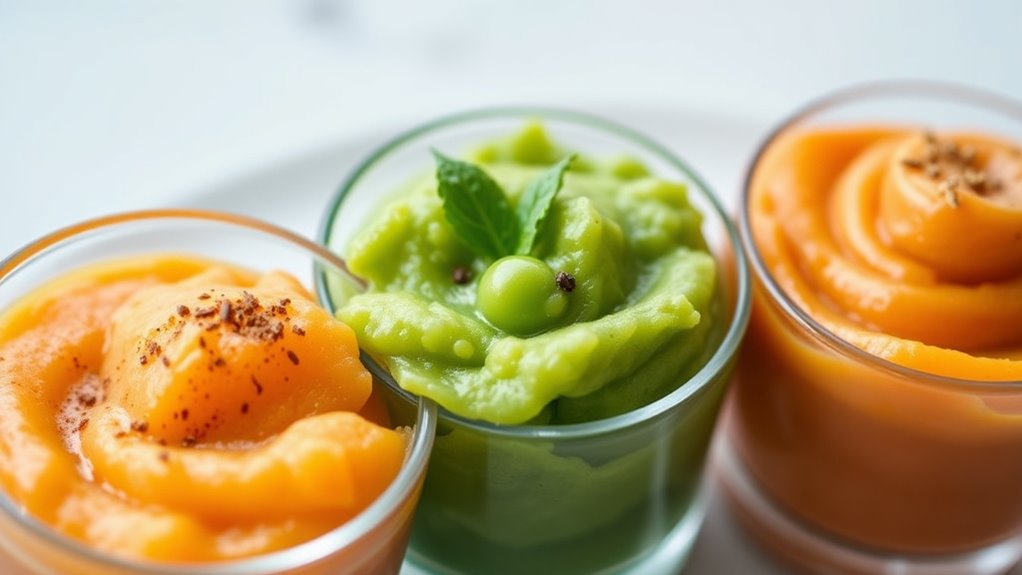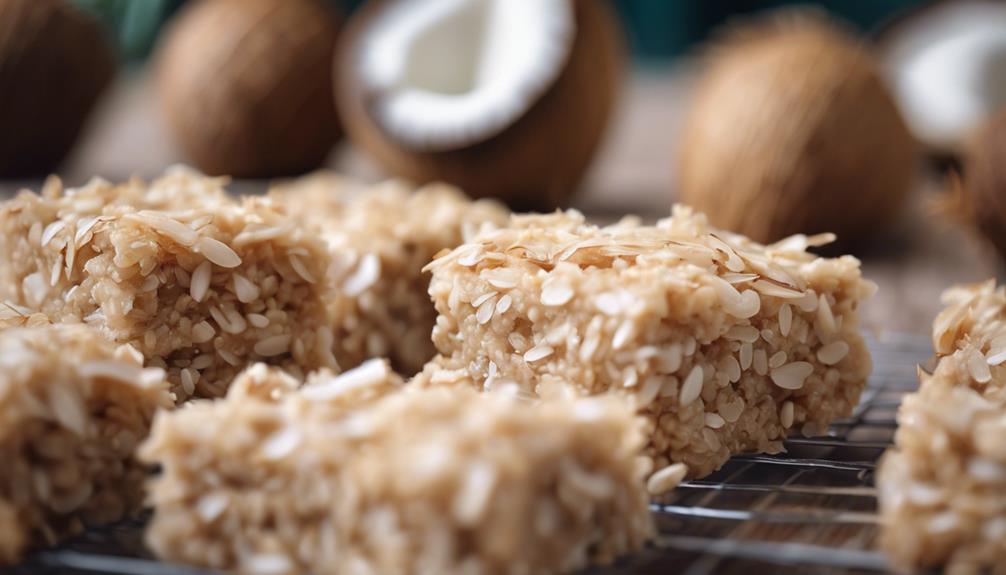To introduce gentle spices into your baby’s purees, start with simple recipes that use mild flavors like cinnamon, ginger, or nutmeg in small amounts. For example, add a pinch of cinnamon to apple or sweet potato purees, or a touch of ginger to pear or carrot purees. Always introduce spices gradually, observing your baby’s reactions, and choose safe, mild options suited for their age. Continue exploring as you learn more about creating tasty, comforting baby food.
Key Takeaways
- Start with mild, baby-safe spices like cinnamon, ginger, or nutmeg, adding just a pinch to purees for gentle flavor enhancement.
- Introduce one spice at a time to monitor your baby’s reactions and ensure tolerance.
- Use spices to naturally enhance the sweetness of fruits and vegetables without overpowering flavors.
- Taste-test purees after adding spices to achieve balanced, gentle flavors suitable for infants.
- Consult with a pediatrician before introducing new spices or flavor combinations into your baby’s diet.

Introducing spices into your baby’s food can add flavor and nutrients, but it’s important to do so safely. When you start incorporating spices, it’s best to focus on simple spice blending to ensure the flavors are gentle and well-balanced. You want to develop a foundation of taste that’s appealing without overwhelming your little one’s sensitive palate. Begin with mild spices like cinnamon, ginger, or nutmeg, which can subtly enhance the natural sweetness of fruits and vegetables. As you become more comfortable, you can gradually experiment with other gentle spices, always keeping in mind your baby’s age and tolerance.
Start with mild spices like cinnamon, ginger, or nutmeg to gently enhance your baby’s natural flavors.
The goal with spice blending in baby food is to promote flavor development without adding heat or strong flavors that could upset your baby’s stomach or cause discomfort. Start by adding just a pinch of spice to your purees and taste-test before serving. It’s a good idea to introduce new spices one at a time, so you can monitor how your baby reacts and ensure they enjoy the new flavors. This cautious approach helps you create a safe and enjoyable eating experience for your little one.
Using spices in baby food isn’t just about making meals tastier; it’s also a way to expose your baby to diverse flavors early on, helping to develop their palate. When you blend spices carefully, you’re encouraging curiosity and acceptance of different tastes, which can lead to healthier eating habits down the line. Remember, the flavor development process is gradual—your baby’s taste buds need time to adapt to new sensations, so patience is key. Incorporating colorful spices can also make your purees more visually appealing and stimulating for your baby’s senses.
As you experiment, trust your senses and observe your baby’s cues. If they seem interested and enjoy the flavors, you’re on the right track. If they turn away or seem uncomfortable, it’s a sign to dial back or try a different spice. Always consult with your pediatrician before introducing new ingredients, especially if your baby has allergies or sensitivities. Keep in mind that the goal is to enhance nutrition and flavor safely, so moderation is essential. Your careful spice blending and attention to flavor development will help your baby appreciate a variety of tastes, setting the stage for healthy eating habits and a lifetime of culinary curiosity.
Frequently Asked Questions
Are Spice Allergies Common in Infants?
You might wonder if spice allergy risks are common in infants. While some children can develop spice allergies, they are relatively rare. Introducing spices gradually helps support flavor development in infants and can help identify any adverse reactions early. Keep an eye out for symptoms like rashes or swelling. If you notice anything unusual, consult your pediatrician. Overall, cautious introduction supports your baby’s taste exploration and safety.
When Is It Safe to Introduce Spices to Babies?
Imagine blending spice flavor combinations into your baby’s meals, just as different cultures do. You can start introducing spices around 8 to 10 months, when they’re ready for new tastes. Begin with mild options like cinnamon or cumin. This approach respects cultural spice preferences while ensuring safety. Always watch for reactions and consult your pediatrician before adding new spices, making mealtime both safe and flavorful.
How Much Spice Is Appropriate for a Baby’s First Puree?
When considering how much spice is appropriate for your baby’s first puree, start with a small amount to gauge their spice tolerance. You want to introduce flavors gradually to support healthy flavor development. Use gentle spices like mild herbs or a pinch of cinnamon, and observe their reactions. As they become more accustomed, you can gradually increase the spice level, helping them enjoy diverse tastes safely.
Can Spices Cause Digestive Issues in Babies?
Spice flavorings can sometimes cause digestive reactions in babies, especially if introduced too early or in large amounts. You might notice fussiness, gas, or diaper changes after feeding. To avoid issues, start with mild spices like cinnamon or cumin, and observe how your baby responds. Always introduce new spices gradually, and consult your pediatrician if you notice persistent digestive discomfort.
Should I Avoid Certain Spices During Teething?
During teething, you might wonder if certain spices could upset your baby’s stomach. While spice preferences vary, it’s wise to avoid highly spicy or irritating spices, as teething can make their gums sensitive. Cultural influences often shape spice choices, but sticking to mild, gentle flavors helps prevent digestive issues. Trust your instincts and consult your pediatrician if you’re unsure, ensuring your baby stays comfortable and happy during this stage.
Conclusion
Introducing spices to your baby’s purees not only enhances flavor but also encourages their palate development. Did you know that babies exposed to a variety of flavors early on are more likely to accept diverse foods later? By experimenting with simple spice combinations, you help your little one develop healthy eating habits and a love for new tastes. So, get creative and make mealtime exciting—your baby’s taste buds will thank you!










